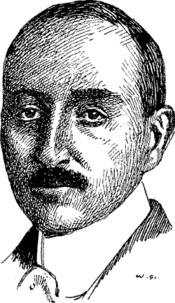Robert von Lieben

Robert von Lieben (September 5, 1878 in Vienna – February 20, 1913 in Vienna) was a notable Austrian physicist.
Education
Lieben attempted gymnasium and then enrolled in a Realgymnasium. However, he left without taking the final examination, the Abitur. He showed a knack for the physical sciences at a young age.
Thanks to his well-off parents (his father, Leopold von Lieben, was president of the Vienna board of trade, and his mother, Anna von Lieben, born of the Viennese Todesco dynasty, owned a mansion at Ringstrasse, across from the opera house), he could independently pursue his scientific propensity. For example, at his father's estate in Mödling he installed electric lighting. After his education he interned at Siemens-Schuckertwerke in Nürnberg.
Military experience
The young Lieben voluntarily enrolled in the military, but only weeks later was discharged after he fell off his horse and was severely injured. From this point on, Lieben's health always troubled him, and an adrenal abscess, which never completely healed, probably contributed to his early death.
Start of an academic career
After auditing classes at the University of Vienna, he studied for one year at the Göttingen Institute for physical chemistry, where he again received no degree. This period of study influenced von Lieben greatly; he and his mentor, Walther Nernst, would speak for hours over radiological discoveries; Nernst, among other things, received the Nobel Prize in chemistry in recognition of his work in thermochemistry.
Discoveries
Back in Vienna, Lieben started a laboratory. The results of the discovery of an electrochemical phonograph and the polarization of X-rays in 1903, as well as the purchase of a telephone factory in Olomouc (Moravia) in 1904, provoked Lieben to develop a telephone amplifier via a cathode beam (electron beam) known as the telephone-relay.
In 1906 von Lieben applied for a patent for his cathode-beam relay: he patented the ability of a magnetic field to deflect an electron ray.
In 1910 he improved the design by adding a control-grid, with which the current density could be varied and consequently amplification attained. Lieben patented this effect. Electrostatic control also underlies the operation of Lee de Forest's Audion (vacuum tube triode), patented in 1907 (U.S. patent 879, 532).
As did de Forest, Lieben encountered a problem with trace amounts of mercury vapor left by his vacuum pump. Mercury ions interfered with proper operation of his cathode-beam relay. This problem was not solved until 1913, through the work of Irving Langmuir in achieving high vacua.
Von Lieben died in 1913, at the age of 34.
Family
Robert von Lieben was born to Leopold von Lieben and Anna von Lieben. His uncles were Theodor Gomperz, Adolf Lieben and Franz Brentano. Heinrich Gomperz was his first cousin.
His niece was Austrian painter Marie-Louise von Motesiczky and grandnephews chemist Martin Karplus and physicist Robert Karplus.
References
- This article is mostly translated from the German page de:Robert von Lieben
- HTS - Das Leben des Robert von Lieben